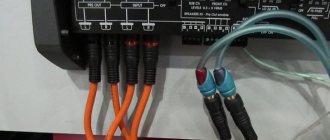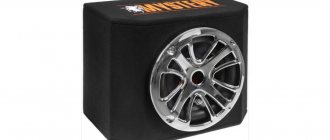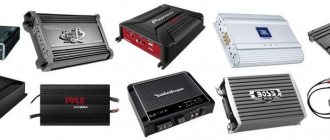How to choose an amplifier for a subwoofer based on power
If for an acoustic amplifier the main attention should be paid to sound quality, then in the case of a subwoofer the key characteristic when choosing is power. It comes in two types:
- Maximum (PMPO). As a rule, it is indicated on the housing and means the total power for all channels with distortion. You should not rely on this indicator, since it does not correspond to reality and serves only as a bait for the buyer.
- Nominal (RMS). Usually recorded in the data sheet or indicated on the box. Rated power is the very figure that should be used as a guide when making a purchase. The parameter should be specified at a THD of less than 0.1% and a voltage of 14.4 V.
Good amplifiers for subwoofers are equipped with a certificate that contains information about the product serial number and the actual power indicator obtained under factory measurement conditions. Such data is traditionally provided by serious companies like Rockford Fosgate, Alpine or MTX.
It is a well-known habit of the majority of companies to slightly inflate the power value in order to attract the attention of a potential client. Against this background, the DLS brand stands out favorably: the manufacturer deliberately slightly underestimates the real figure, moving into a lower category of devices, where it easily maintains leadership.
There is endless debate about what the amplifier power value for a subwoofer should be. There are only three points of view:
- It is necessary that the amplifier be less powerful compared to the subwoofer. This opinion is erroneous, since a weak device will cause the voice coil to burn out.
- Preference should be given to an amplifier that is equal in power to the subwoofer. In this case, there is also a catch - the rated power is normalized for a voltage of 14.4 V, which is almost never maintained at the amplifier outputs. This situation is fraught with overheating of the voice coil.
- It is better that the amplifier exceeds the subwoofer in power. The best option from a security point of view for equipment. The only risk is the possibility of mechanical damage to the coil, but this can be avoided by not turning the speaker to maximum and not listening to ultra-low frequency tracks too often.
Since the superiority of an amplifier over a subwoofer in terms of power gives the greatest chance of a long period of useful operation of the devices, it is recommended to prefer this option. Also, there is ongoing debate on the Internet about the required number of watts. As practice shows, it is better to choose an amplifier model 1.5-2 times more powerful than a subwoofer.
Why might a car amplifier fuse melt?
Often, to get the best sound from the audio system in their car, the user has to install a new head unit, amplifier and speakers. In principle, at first glance, this seems cool, but quite often a new problem arises when the amplifier fuse begins to heat up and melt. What could be causing the fuse to keep melting?
There are several types of car amplifier fuses in a typical installation. Some people distinguish 2 types, others 3. Thus, the cause of the problem in your specific situation will be the type of fuse installed. If there is a power cable connected from the amplifier directly to the battery with a built-in fuse, the reason may be that the main fuse of the battery or the internal fuse of the amplifier is blowing, while other components of the entire circuit are independently drawing power from the fused distributor. In any case, the main reasons are that the short circuit originates in the amplifier's fuse and extends along the power supply line, and to determine the exact source of the problem, you will need a voltmeter.
Use a voltmeter to determine a bad fuse.
The first step in determining the cause of a blown fuse is to pinpoint the faulty fuse. And if you have already replaced the fuse, and you are absolutely sure that this is the problem, you can simply skip this step. If you still have not identified the defective fuse, it is important to understand that you cannot replace it with a fuse with a higher amperage rating. The option of using a fuse with a low amperage rating will be safer.
The crux of the problem is that fuses melt if more current is passed through them than they can handle, and a hot fuse handles less amperage than a cold fuse. Thus, if the original fuse heats up and melts, a new fuse with the same characteristics may cause the amplifier to malfunction by passing more current than the previous one, thereby causing further internal damage. If you use smaller fuses in your next diagnostic, you will be able to pinpoint the source of any shorts or faults, and you will be less likely to damage your amplifier in the future.
In any case, you need to determine the number of fuses on the power distribution line, and check the voltage on both sides of each fuse. Some amplifiers are connected directly to the positive terminal of the battery, through a single line fuse, or thanks to a built-in fuse, while others receive their power from a distributor, which in turn is connected to the main fuse.
Although technically fuses can be checked visually, it is still better to use a voltmeter or ohmmeter. This will be a more effective way. It is necessary to check the voltage on both sides of each fuse, starting with the main or battery fuse. If the fuse has the same voltage at both terminals, that's good. If there is tension on only one side, this is bad. Once the defective fuse has been identified, you can proceed to the next step.
Amplifier for subwoofer: which one to choose? Technical specifications
For an amplifier, only the power indicator is critically important; the remaining characteristics can be looked at in so many ways. But you should still pay attention to the following parameters:
- Frequency range. The user needs to ensure that the spread is not too large. Serious companies give the most specific values - for example, from 15 to 350 Hz. If the range is specified within 10-500 Hz, then most likely this is just a marketing trick, and the amplifier will not work well at the stated frequencies.
- Amplifier class. He can be:
- AB is an analog device with good amplification quality, but low efficiency and the same power;
- D is a powerful digital amplifier that demonstrates high efficiency, but has poor performance.
- Number of channels. According to this criterion, devices are divided into the following groups:
- single-channel (monoblocks) - designed for low-resistance loads within 1-2 ohms. They are rare, mainly in professional car audio systems, where the output power is much more important than the sound quality. They almost always belong to class D. Good examples are DLS XM10, Alpine PDX-M6, DLS MAD15;
- two-channel - designed for subwoofers designed for 4-8 ohms. They can be connected via a bridge circuit or via a subwoofer/coil if there is sufficient power. The following models have proven themselves well - Eton SR 100.2, Genesis Profile Two, DLS MA23;
- three-channel - practically never found, as they are replaced by 4-channel amplifiers;
- four-channel – are the most popular. Such devices can be used for 4 speakers, a subwoofer and a pair of speakers, as well as 2 subwoofers. Due to their versatility and ease of installation, 4-channel amplifiers are recommended in most cases. For example, you can choose one of the following models - Focal FPP 4100, Alpine PMX-F640, Eton SR 60.4, DLS XM40;
- five-channel - are four-channel amplifiers with an additional subwoofer channel, thanks to which you can also connect front and rear speakers. These models allow you to save space and also spend much less money than if the amplifiers for the subwoofer and speakers were installed separately. It is worth paying attention to such devices – Audison SR 5, DLS MA51, Alpine PDX-V9;
- six-channel - almost never used, since a rare car audio system requires such amplifiers. But there are still 6-channel models on the market, for example, Gladen XS 75c6 and Mosconi Gladen One 60.6.
What amplifier is needed for S 90 speakers?
In the reference book, an amplifier
20-90 W.
To pump up the S-90 with its sensitivity of 85 dB, you need about 200 watts of power, they won’t stand it for long. It’s easier to buy professional speakers
that are played at holidays and concerts; they have a sensitivity of 95 dB.
Interesting materials:
What programming language should you learn in 2022? What is the ideal weight for a height of 167? What is the ideal weight for a height of 170? What is the ideal weight for a height of 174? What is the incubation period for whooping cough? Which iPad to get in 2022? What HDMI cable comes with PS5? What cough is considered dangerous? What kind of cough is considered dry? What kind of kefir is considered fresh?
Power
Power is the main parameter when choosing an amplifier; the sound quality and safety of the speaker will depend on the correct selection.
More than once I have heard the opinion that the amplifier should not exceed the power of the subwoofer so as not to burn it - THIS IS NOT TRUE!
Remember the rule - excess power is better than insufficient
The speaker will burn out much faster if there is insufficient power input and the resulting distortion (clipping).
With equal values, the subwoofer will still not have enough control, since a reserve is needed to pass short-term peak loads. With this headroom, the bass will be tighter, faster and deeper.
Imagine that you are pressing a barbell from your chest, and your maximum working weight is 100 kg, if you start lifting a 120 kg barbell, it will not break, but you can, if you take the weight corresponding to your working weight, you will cope with every effort and in the last During repetitions, your hands may shake, but if the barbell weighs 80 kg. you will calmly complete your work without jerking or struggling, and you can maintain any pace during the process. Here is a rough example from a remote area, but it gives a good idea.
When studying equipment characteristics, do not pay attention to flashy numbers such as 1000 Watts. etc., while the brighter and larger the numbers, the further they are from the truth.
Focus on the RMS value, many people confuse it with rated power, but in fact RMS is the maximum (limit) sinusoidal power at which an amplifier or speaker can operate for one hour with a real music signal without physical damage. But let’s not get bogged down in definitions, especially since this parameter will be the right guideline when choosing.
Sub
Which amplifier to choose for a subwoofer
The most difficult speaker to artificially amplify is the sub. It is for this reason that so many large-sized subwoofer amplifiers are produced today. They are designed specifically for amplification of low frequencies. Here's what it's recommended to know for those who are thinking about improving the sound of a subwoofer:
- 1-channel or mono amplifiers are capable of operating with a wide range of impedances. Such devices have a special tone setting, separate filters that help thunderous bass erupt at full power;
- 2 and 4-channel “amplifiers” are also capable of subwoofer amplifiers, but they are not able to cope with the effect of low impedance. They quickly overheat as soon as the sub starts playing at full power.
How to choose an amplifier for a subwoofer
The ideal amplifier option for a low-frequency driver, which will enable the subwoofer to produce an excellently balanced sound, is a device characterized by the following parameters: 50-200 watts.
Note. It is important to know the impedance of the amplifier and subwoofer. Otherwise, buying the first one will be a waste of money as it will not be possible to integrate with the speaker due to mismatch. In principle, it will work, but it will constantly overheat.
Number of channels
Monoblock
A single-channel amplifier is made specifically to work with a subwoofer; therefore, it has one channel and is characterized by increased power, sometimes to the detriment of sound quality. Choose it if you need a lot of loud bass.
Two channel amplifier
There is an opinion that a two-channel amplifier operating in a bridge (more about bridge connection) sounds more pleasant than a monoblock. It is worth choosing it as a separate amplifier for a subwoofer when you want “better quality” sound, perhaps at the expense of power or budget.
Four channel amplifier
You can connect a subwoofer to a four-channel system with a bridge, and use the remaining couple of channels for acoustics (for example, connect mids and tweeters through crossovers), thereby covering the entire audio system with one amplifier. But such an amplifier with enough power for a normal subwoofer will have a high price.
Five channel amplifier
This amplifier has a dedicated channel for the subwoofer and can provide channel-by-channel amplification (a separate channel for each speaker) of the entire system if you have a “two-room + sub”. A utilitarian solution, but this is not suitable for powerful, pronounced bass, since the all-in-one form factor does not allow you to squeeze in large fillings. But if you don’t have a loud and quiet system, you can choose this option, although the choice in five-channel systems is relatively small.
Unfortunately, no matter how much you would like the opposite, the stubborn law of “better is more expensive” operates in the car audio market; there are exceptions, but they are quite rare. Therefore, you won’t be able to cheat fate and get super quality at a bargain price.
To figure out what price range to choose a subwoofer amplifier in, understand that an audio system only sounds as good as its weakest component. In other words, the advantages of one component cannot offset the disadvantages of another. This means that if you have an amplifier for 100,000 rubles, and a subwoofer for 3,000 rubles. then this combination will sound at 3,000, so balance and proper budget allocation are always necessary. Therefore, it all depends on your “appetite”.
Why might a car amplifier fuse melt?
Often, to get the best sound from the audio system in their car, the user has to install a new head unit, amplifier and speakers. In principle, at first glance, this seems cool, but quite often a new problem arises when the amplifier fuse begins to heat up and melt. What could be causing the fuse to keep melting?
There are several types of car amplifier fuses in a typical installation. Some people distinguish 2 types, others 3. Thus, the cause of the problem in your specific situation will be the type of fuse installed. If there is a power cable connected from the amplifier directly to the battery with a built-in fuse, the reason may be that the main fuse of the battery or the internal fuse of the amplifier is blowing, while other components of the entire circuit are independently drawing power from the fused distributor. In any case, the main reasons are that the short circuit originates in the amplifier's fuse and extends along the power supply line, and to determine the exact source of the problem, you will need a voltmeter.
Use a voltmeter to determine a bad fuse.
The first step in determining the cause of a blown fuse is to pinpoint the faulty fuse. And if you have already replaced the fuse, and you are absolutely sure that this is the problem, you can simply skip this step. If you still have not identified the defective fuse, it is important to understand that you cannot replace it with a fuse with a higher amperage rating. The option of using a fuse with a low amperage rating will be safer.
The crux of the problem is that fuses melt if more current is passed through them than they can handle, and a hot fuse handles less amperage than a cold fuse. Thus, if the original fuse heats up and melts, a new fuse with the same characteristics may cause the amplifier to malfunction by passing more current than the previous one, thereby causing further internal damage. If you use smaller fuses in your next diagnostic, you will be able to pinpoint the source of any shorts or faults, and you will be less likely to damage your amplifier in the future.
In any case, you need to determine the number of fuses on the power distribution line, and check the voltage on both sides of each fuse. Some amplifiers are connected directly to the positive terminal of the battery, through a single line fuse, or thanks to a built-in fuse, while others receive their power from a distributor, which in turn is connected to the main fuse.
Although technically fuses can be checked visually, it is still better to use a voltmeter or ohmmeter. This will be a more effective way. It is necessary to check the voltage on both sides of each fuse, starting with the main or battery fuse. If the fuse has the same voltage at both terminals, that's good. If there is tension on only one side, this is bad. Once the defective fuse has been identified, you can proceed to the next step.
Diagnosis of a blown car amplifier fuse.
If you find that the main fuse has blown, try to determine the timing of when this could have happened. Test the new, properly sized fuse with the car's head unit and amplifier, then turn off the system. If the fuse immediately overheats and melts while the system is off, most likely you are dealing with a short somewhere on the power wire, between the main fuse and the distribution block, or the fuse and the amplifier if the system does not have a distribution block. When testing, in normal operating condition, the ohmmeter should provide “overload” data. If this type of data is displayed continuously, you will need to check the entire power cable connection to determine where it is grounded. In some cases, a worn power cable may sag and rub against the ground when the vehicle is moving, for example, when you drive over potholes or drive over speed bumps.











